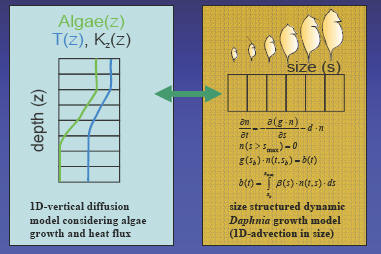
Modellierung des Einflusses von physikalischen Umweltveränderungen auf die Plankton Sukzession mit besonderem Fokus auf Daphnien-Algen Interaktionen
Global change is expected to alter the physical conditions in lakes. This project will develop a plankton succession model and combine it with a 1 dimensional physical model to investigate the effect of changes in the physical environment and specifically in water temperature on plankton succession. In the two year application period the plankton succession model proposed will be focused on phytoplankton and Daphnia, because phytoplankton abundance is mainly determined by the availability of nutrients and light, whereas Daphnia growth is highly sensitive to water temperature. The plankton succession model will also include in a simplified fashion fast growing microzooplankton feeding on phytoplankton and the predation of fish on Daphnia. Sub-models resolving different details (e.g. size structure, stoichiometry) of Daphnia development will be included to investigate the importance of model detail on the overall model behaviour with respect to field observations.
Model calibration and validation will be based on the extensive data set available for Lake Constance. Comparison of data and model results on the plankton succession in years with extreme thermal conditions will be used to investigate whether the impact of changes in the physical environment on plankton succession can be adequately simulated and possibly leads to a shift in the interactions within the plankton community (match-mismatch). Because the ecosystem in spring and early summer is very sensitive to external forcing and dominated by only a few species, the main part of the investigations will initially concentrate on spring and early summer. Consequences of global warming on the physical parameters and the implications on the plankton succession will be studied using numerical experiments.
The modeling work will be complemented by field measurements during late winter and early spring to provide data with a better temporal resolution on the plankton development, and to improve the data quality for especially daphnids, which is rather poor in the existing data set because only few individuals were obtained within one zooplankton sample.
Depending on the outcome of the modeling work during the two year application period we will apply the plankton succession model to study other time periods of the year, other lakes, mesocosms or extend the model by considering additional species.
